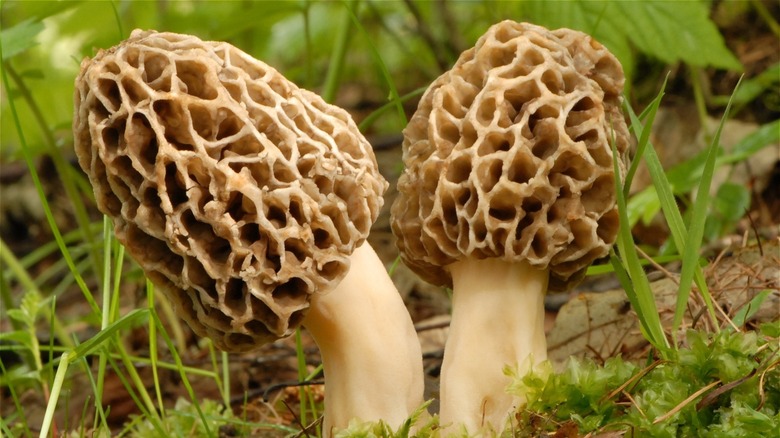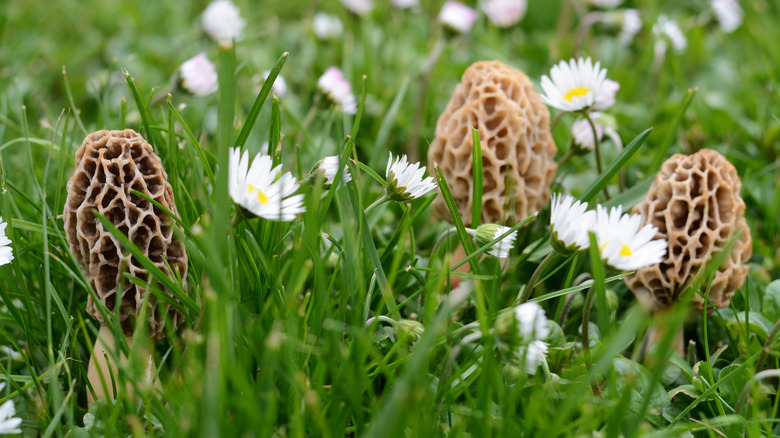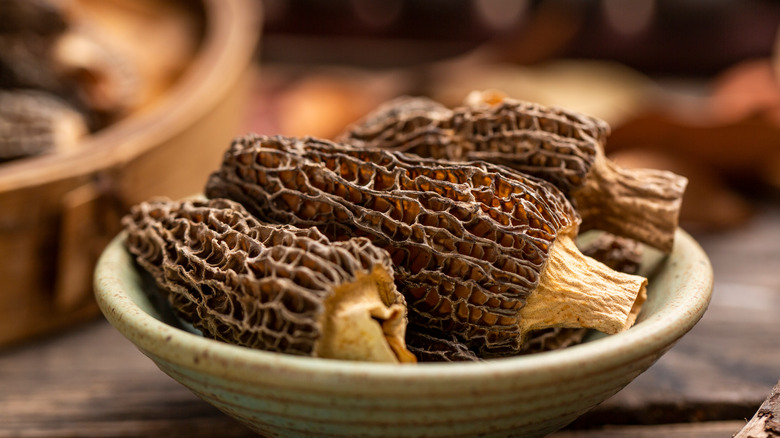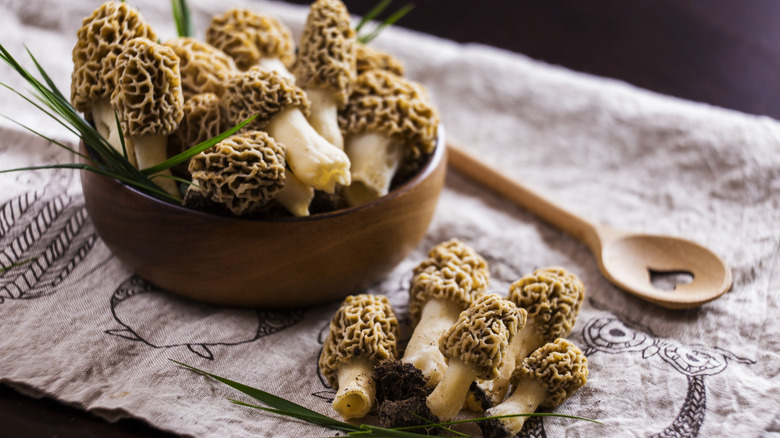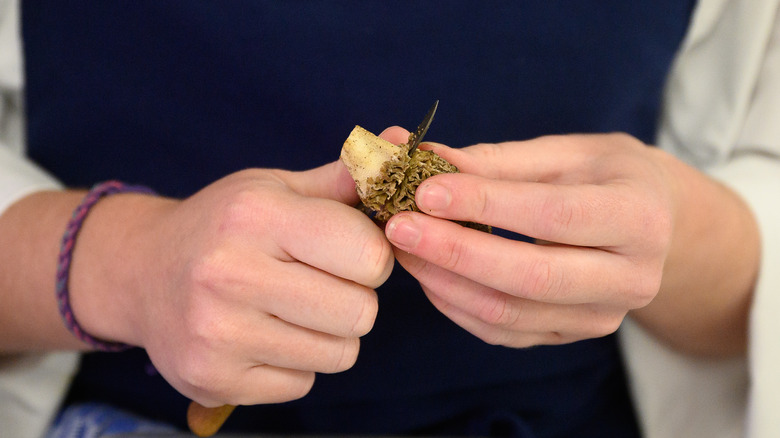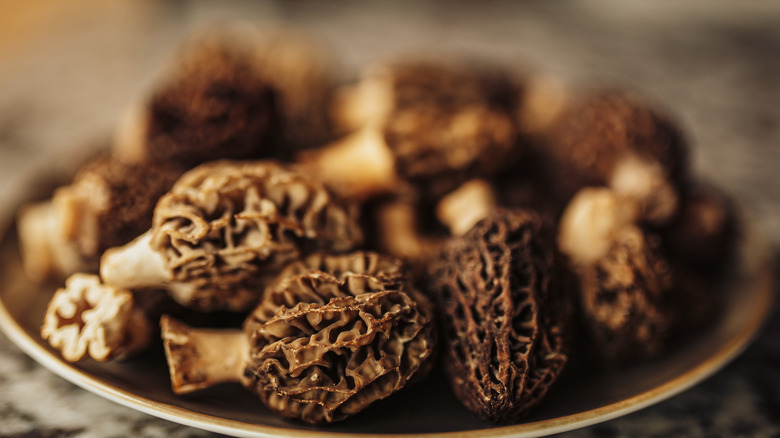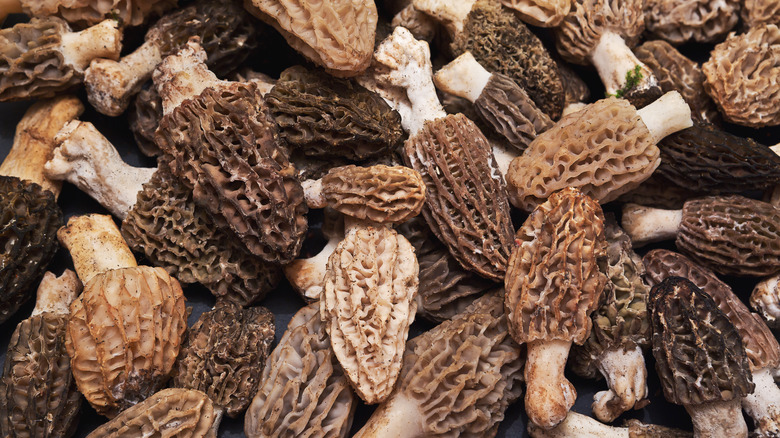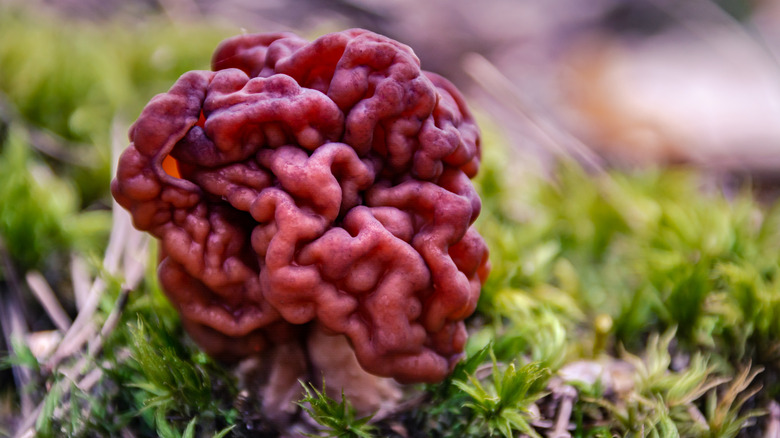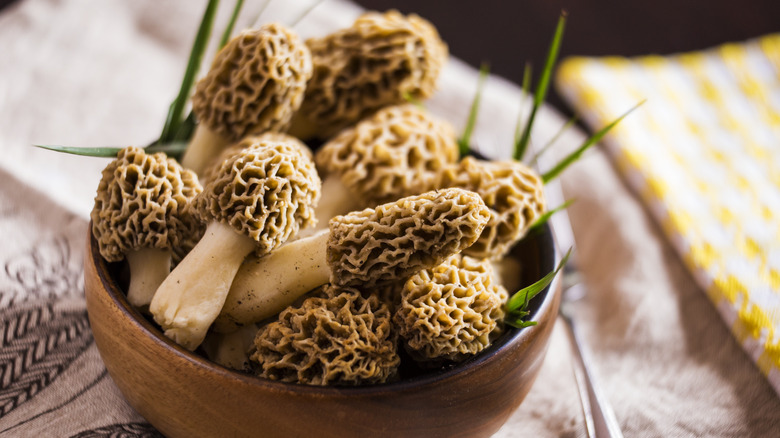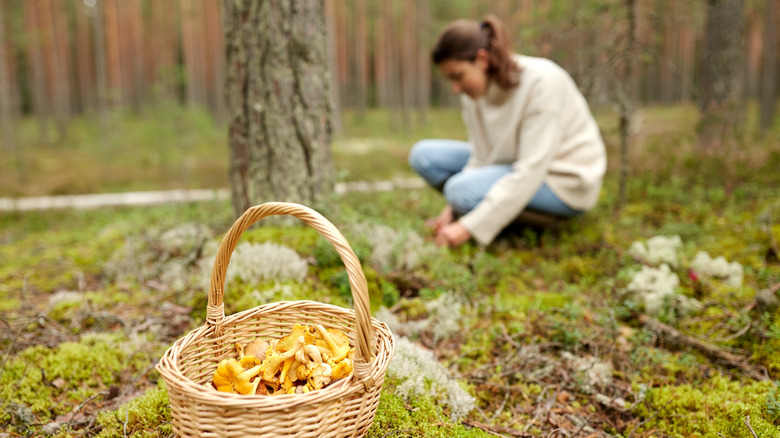What Are Morel Mushrooms And Why Are They So Expensive?
We may receive a commission on purchases made from links.
Mushrooms are the sort of food that most people either love or hate. But if you love them, then you probably know that there's a whole world out there beyond the white button mushrooms you get at the grocery store. Whether it's shiitake, oyster, hen-of-the-woods, or enoki, these edible fungi come in many prized varieties. But morel mushrooms (Morchella) are one of the most coveted types out there. Iron Chef Alex Guarnaschelli even once called morels the "sacred mushroom" (via Food Network).
The morel mushroom is prized for its unique structure and subtle earthy flavor (via Specialty Produce). Morel mushrooms come in a wide variety of colors and shapes, but one distinctive characteristic is the pitted outside of the mushroom — some say it resembles a honeycomb. Fungi-lovers go so wild for morels, that they even have clubs, websites, and books dedicated to the species (via Mushroom Appreciation). But even folks who might consider them priceless know these mushrooms don't come cheap. Here's everything you need to know about morels.
What are morel mushrooms?
Identifying and classifying mushrooms is a hard job. FoodPrint writes that 50 or more species of morel exist. But Midwest American Mycological Information notes that DNA testing is changing the way species are classified. There's a lot of uncertainty, but here's what we do know about morel mushrooms.
They're a type of sac fungi and belong to the phylum Ascomycota, along with lichen, truffles, and yeast. Morels have a hollow stem and an oblong cap that's usually longer than the stem. Both the cap and stem are edible. The cap is attached to the stem, and the cap has many pitted indents (perfect for soaking up butter). Morels grow in the wild, especially near certain types of trees, including elm trees, apple trees, ash trees, and tulip poplars (via The Great Morel).
Depending on the species and age, the color of morel caps can be different shades of black, yellow, gray, red, or white. Morels are usually about the size of a thumb in early spring, but as the season progresses they can grow to 4-5 inches, per Better Homes & Gardens. Some lucky foragers have even found morels 15 inches tall and weighing more than 1 pound (via The Meat Eater). However per the Missouri Department of Conservation, on average, black morels and half-free morels are about 2-4 inches tall, with ½-inch to 2-inch-tall caps, and yellow morels are larger, with caps 2½–6 inches tall on top of 1- to 2-inch-tall stalks.
Fresh morel mushrooms vs dried morels
The two types of morels people cook with are fresh morels and dried morels. If you're using fresh morels, you don't need to do much to prepare them for cooking. You should store your morels in a paper bag in the fridge. When ready to cook, you can run them under cool water, using a toothbrush to gently get rid of any dirt clinging to the cap and stem. Some people also cut the mushroom in half to rinse out any dirt or insects caught in the hollow stem. If the stem seems too woody, it can be removed. Dry your mushrooms, and they're ready to cook (via The Kitchn).
Dried morels require a little more planning ahead because they need to be soaked. Just soak them in hot water, wine, or stock for 15-20 minutes, until they are soft (via Great British Chefs). You can also save the morel mushroom soaking liquid to use as a stock (make sure you filter it to remove any grit) when making rice, risotto, soups, and sauces. Once rehydrated, your morels can be cooked just as you would cook fresh mushrooms.
What do morel mushrooms taste like?
Mushrooms in general are prized for their savory, umami flavor, but each variety tastes a little different. While some, like shiitake, have an especially robust flavor, others, like morels, are milder. Morels are prized for their delicate flavor, which some people say is nutty, earthy, and sometimes even a bit smoky (via Simply Recipes). The nuttiness and earthiness tend to be higher in darker morels (via Allrecipes). The mushrooms can be prepared simply, sauteed in butter or simmered in cream, to let their subtle nutty flavor shine and not be overwhelmed by other ingredients.
Texture also sets morels apart. While some other mushroom species can be slimy, morels feel more meat-like. Combined with their delicate, nutty flavor, this makes morels a good entry point for people who think they don't like mushrooms — they have a milder and less funky flavor and more appealing texture than other varieties.
How to cook with morel mushrooms
It may be tempting to try to taste fresh morels while they're raw, but this would be a mistake. That's because the toxin hydrazine is found in morels (via FoodPrint). Eating raw morels can result in gastric symptoms including diarrhea, vomiting, and more. They should always be cooked thoroughly. Luckily, there are many ways to cook with morels. First, make sure that your morels are clean (if using fresh) and hydrated (if using dried). Because morel mushrooms are so expensive and such a prized ingredient, they're usually cooked simply in order to let their flavor shine. One foragers' favorite? Fried morels, which have a crispy outside and juicy interior that really highlights the flavor of the mushroom (via Hunter Angler Gardener Cook).
Some sources, like the Michigan Department of Community Health, say that eating morels with alcohol can increase your chances of "becom[ing] ill." FoodPrint says alcohol could make someone more sensitive to hydrazine and that you should be cautious of pairing these mushrooms with wine. However, Wine Enthusiast actually claims morel mushrooms pair well with both red and white wine, and you can find many recipes online that pair cooked morels with wine. Chef Haidar Karoum told the magazine, "All mushrooms go really well with wine but ... morels ... because of how earthy [and] meaty they are ... work well with wine. They're highly cherished." So not everyone is wary of this combo.
Where to buy morel mushrooms
Unlike button mushrooms, cremini mushrooms, and portobellos, you probably won't find fresh morel mushrooms year-round, and they probably won't show up at regular grocery stores. You'll want to head to a specialty store or to the farmer's market to buy fresh morel mushrooms when they're in season (via The Spruce Eats). Morels have a very short season in the spring and early summer (from March or mid-April to mid-June,) so it's more common to find them dried (via The Great Morel).
You should be able to find dried morels online or in stores like Whole Foods. When selecting your mushrooms, dried or fresh, you'll want to look for a pitted, "brain-like texture" on the cap, a hollow stem, and only a small amount of discoloration on the stem and cap (the aging process tends to darken them). Once purchased, fresh morels should be cooked within one week, while dried morels should be kept until the date specified on their packaging.
Nutritional information about morel mushrooms
Per Allrecipes, morels provide plenty of protein, fiber, and antioxidants but few calories and little fat. According to the U.S. Department of Agriculture's FoodData Central, 1 cup of raw morels contains 20.5 calories, 2.06 grams of protein, and 1.85 grams of fiber. They also possess copper and potassium (0.413 milligrams and 271 milligrams, respectively, per cup of raw morels — for reference, one banana has about 375 milligrams of potassium, according to the USDA). They're also a plant-based dietary source of Vitamin D. Not a lot of meatless foods are rich in Vitamin D, but 1 cup of raw morels contains 136 IU of Vitamins D2 and D3. However, the Mayo Clinic says young adults need a minimum of 600 IU Vitamin D, and adults over 70 need 800, so you'd have to eat a ton of them to meet your daily need.
On the flip side, eating too many morels can also cause distress (via Michigan Department of Community Health). Pairing them with alcohol has been linked with illness, and people should abstain from consuming them raw. In 2011, the head of Detroit's Children's Hospital of Michigan Regional Poison Control Center told MLive that genetics can predispose people to be sensitive to morels, but others could be fine eating them for years and unexpectedly become sensitive. Those with penicillin or mold allergies should be cautious, too. Certain proteins present in mushrooms are similar to those in mold and could cause a reaction (via Verywell Health).
Other varieties of morel mushrooms
There are several types of edible morel mushrooms. The most common is the yellow morel (Morchella esculentoides), but black morels (Morchella angusticeps) are also popular (via Missouri Department of Conservation). Another edible variety is half-free morels (Morchella punctipes), where the bottom of the mushroom cap hangs free from the stem (most morel caps are fully attached to the stem), but these can be hard to identify, and so are less commonly eaten.
However, there are some inedible mushrooms called "false morels" (such as Gyromitra caroliniana and Gyromitra brunnea), which look like edible morels but can actually be toxic even after they're cooked, thanks to the toxin monomethylhydrazine (via the University of Wisconsin-La Crosse). Even the fumes while cooking these mushrooms can be toxic. If you're a novice mushroom hunter, you'll want to be extra careful when foraging. One key difference? True morels have a hollow stem, while false morels have a solid, "cottony" stem (The Great Morel). As mushroom hunters would tell you, "When in doubt, throw it out" — it's always safer to err on the side of caution.
Why are morel mushrooms so expensive?
Morels can garner a price tag of at least $30 per pound or double that when not in season (via Michigan State University). Shipping them can cost even more (Northwest Wild Foods would charge $190 for 4 pounds). That's because, unlike most mushrooms that you buy in the grocery store, morels aren't farmed — the development of the actual morel mushrooms from the fungus is too spontaneous to replicate in the lab or in a commercial setting (via The Kitchn). Instead, they're gathered in the wild, and preferably by someone who knows what they're doing since some lookalike species are poisonous (via Encyclopedia Britannica).
If you want to try morels at a less outrageous price tag, consider buying them dried, then rehydrating them before you cook. They can be more expensive by weight than fresh morels, but a description on Amazon states that "it takes 7 pounds of fresh morels to make 1 pound of dried." You could also travel to a place where morels are found in the wild and try them there. Morels don't last long once picked and would have to be chilled or dried. Ken Litchfield of the Mycological Society of San Francisco called drying "the most efficient" method of collection and preservation. If you want to get a taste on a budget without foraging or traveling, you could try treating yourself to a small amount. Per Litchfield, just ¼ to a ½ pound can infuse a recipe with flavor.
A few tips on foraging for morels
Some people skip the shipping, head to the forest in the spring, and forage for morels. But let's be clear: We are not experts on morel-hunting, and this is not a foraging guide. Foraging for morels can be dangerous. As the Michigan Department of Community Health pointed out, misidentification can lead to hospitalization. So, first of all, a would-be hunter would need to make sure they can tell the difference between edible true morels and toxic false morels. According to certified mushroom expert Keith Langdon, it's important to observe the refrain, "When in doubt, throw it out" (via MLive).
Knowing where to look can be tricky. There's no guarantee that the same morel patch will return year after year. Morels like to grow on recently disturbed ground, so it would make sense to check any areas where the ground has been disrupted (like by logging), moved by water (like in a previous flood area), or even burned by wildfire (via Mushroom Appreciation). There are also certain tree species they often grow beside, so learning to identify those trees — ash, elm, apple, tulip poplar — could help a forager find morels (via The Great Morel). If you can safely spot them, don't pick every morel you see in a patch — leaving some to drop spores means they might reappear next year. You should also carry your finds in a mesh bag so that as you traverse the forest they'll disperse their spores on the ground.
